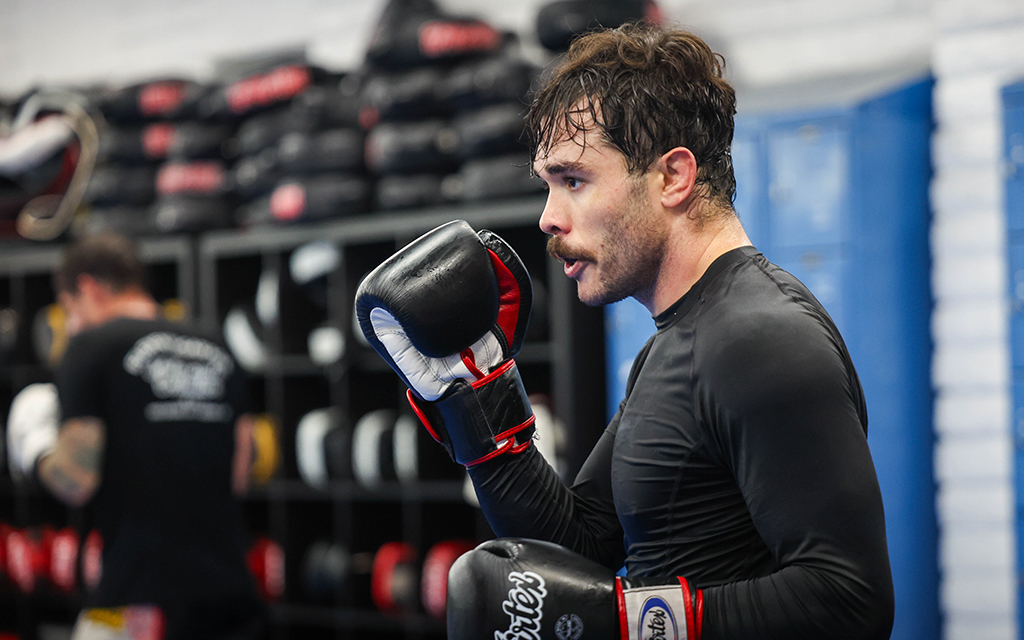TEMPE – Mixed martial artist Cedric Katamba, who fights out of Arizona Combat Sport, has a unique approach to cutting weight and resisting the urge to eat foods his body is craving during the process.
“I’m on my phone looking up the foods I’m going to eat,” Katamba said. “Some people attempt to stay away from those things, but I love staring at food that I can enjoy after my fights.”
Cutting weight is a necessary evil in mixed martial arts, wrestling, horse racing and other sports for men and women that require fitting into weight categories. Only so many pounds can be lost by sweating. The rest requires eliminating calories, and that takes discipline – and creativity, like Katamba’s.
Athletes become even more aggressive in their weight cutting as competition approaches. In MMA, it has been described as the “weight cutting week,” during which a fighter cuts pounds to qualify at a lower weight class and then bulks up as quickly as possible in the 24 hours between the weigh-in and fight, allowing them to enter the octagon well above their weigh-in weight.
There’s a fiery passion that drives these combat fighters to feel alive inside the cage. Thus, they put their bodies through the wringer, first cutting back on food to lose weight, then finishing off the cutting process by severely dehydrating themselves in the final hours before a weigh-in – often all on short notice in an effort to have an advantage over the competition and make a living in the sport.
“It’s the fight before the fight,” said Trevor “Hot Sauce” Smith, a former Ultimate Fighting Championship competitor and StrikeForce fighter, of the weight-cutting ritual. “I honestly enjoyed the challenge of cutting weight.”
Smith’s “walking around” weight was between 205 and 215 pounds while he was competing, but he would drop to 185 pounds for his bouts. For mixed martial artists, it’s just part of the job.
“You know you’re going to suffer,” said Jake Armenta, a mixed martial artist fighting out of Arizona Combat Sports. “You get comfortable being uncomfortable doing this sport. I know the hardest battle for me is going to be making weight on the scale.”
Like Katamba, Armenta has become more creative. He has been cutting weight nearly his entire life and said going to a vegetarian diet has made his typical eight-week training cycle less strenuous on his body and allows him to recover faster.

Unlike other MMA fighters, Cedric Katamba loves to visualize the foods he plans to eat after cutting weight for a fight. (Photo by Reece Andrews/Cronkite News)
“It’s a lot easier for me to control my calorie consumption when I’m vegetarian,” he said. “Meats are pretty high in density. What I’ve found while I’m losing weight, those calories affect my lactic acid because I’m a lot more likely to get injured.”
Dramatic weight cutting can give athletes an advantage, but it also can lead to trouble.
Food is the body’s fuel and studies have identified eating disorders that are more likely to be found in combat fighters due to their cravings during their training. There also is a long history of eating disorders among jockeys in horse racing. It can be a dangerous practice if not utilized in the right circumstances and with proper supervision.
Smith, who is now a trainer at Arizona Combat Sports, remembers waking up on the day of weigh-ins and putting on a sweat suit, getting onto the treadmill to run, and then sitting in the sauna to sweat away pounds. He said today’s fighters should aim to cut no more than 10 pounds before the fight. Smith’s routine often included sweating off as much as five pounds in the sauna on the day of a weigh-in.
“I crash-weighted and dropped 30-35 pounds during camp,” he said. “But I’d lose 20 of the pounds the week of the fight. I didn’t want to feel as dehydrated, which is why I waited to cut until the last week.”
It took a toll.
“I was sitting in my hotel room in Wisconsin waiting for the UFC to come pick me up, and I felt as if I was going to pass out,” Smith said of one weight-loss experience. “It’s beyond a mental challenge.”
Having more muscle mass, which is typical of combat athletes, makes it easier for the body to shed sweat, making the weight-cutting process smoother. But not necessarily easier.
“Obviously, sitting in a sauna takes more out of your body, but it makes you lose weight quicker,” Smith said.
Smith put Himalayan sea salt in his water to help him rehydrate. At that point, thirst was a bigger issue than hunger.
“To me, it was what liquids am I putting back in my body,” he said. “Food was the last thing on my mind.”
The majority of athletes drink eight liters of fluid every day for a certain period, then cut out drinking fluids altogether. This, theoretically, allows the body to “flush out” water.
Such water loading is said to trick the body into urinating more, according to The Fight Dietitian. Research suggests that the hormone vasopressin counteracts water retention signals. Vasopressin levels decrease when water retention levels are reduced.
“The best way to rehydrate before (UFC) banned it, was to get IVs to easily cut the 20-30 pounds,” Smith said, “You’d have a couple bags of IVs using saline solution and you got the salts in your system. It made it a lot easier and you’re rehydrating quicker.”
Amanda Lemos underwent an extreme weight cut in anticipation of her UFC title fight with Zhang Weili at UFC 292 in August. Video clips show her stepping out of a sauna tent with the help of her coach, before being wiped down. Then to continue the water-weight loss, she is tucked into Mylar sheets. The Mylar retains the body’s core temperature and prolongs sweating.
The weight loss often results in hollow cheeks, visible vascularity over muscles and dark rings under the eyes.
“There’s cardiovascular stress that shows to me that that individual has electrolyte and dehydration,” said Crystal Scott, a registered sports dietitian for Top Nutrition Coaching regarding Lemos’s weight cut. “And they usually have raccoon eyes as well, too.
“So they have significant darkening of the under bag (below the eye). And that can put a lot of pressure on the cardiovascular system, which leads to increased heart rate, elevated blood pressure and heart-related issues.”
Studies document maladies resulting from weight loss such as dizziness, headaches, seizures, fatigue and lightheadedness, as well as greater exposure to concussions because of depleted fluid around the brain. It’s one of the reasons weight-cutting athletes try to rehydrate as much as possible after weigh ins.
“F——- miserable,” Smith said of the process, laughing loudly behind the front desk of Arizona Combat Sports entrance.

Carbohydrates and salt are avoided by fighters for the best weight-cutting results during training. On average, fighters typically cut 15-20 pounds ahead of a weigh-in. (Photo by Reece Andrews/Cronkite News)
There are 11 weight classes affiliated with mixed martial arts. Often, people believe that athletes who cut weight will have an advantage in competition as a result.
It’s the same in college and even high school wrestling, where up to a third of athletes take part in cyclic weight cutting, according to the National Federation of High School Associations. As a result, the NFHS has established rules to discourage cutting.
Armenta said that his burning desire and underlying competitive attitude drive him to fight through the process leading up to his fights.
“It’s definitely the love and competition that pushes you through weight cutting, knowing that cutting the weight will give us an edge in winning in the cage,” Armenta said. “It’s why we invest so much time in this sport.”
Scott said mixed martial arts “fighters are some of the most dedicated individuals that I have ever had the pleasure of being able to work with.”
Still, Scott believes that having a transparent conversation between dietitians and fighters is essential for any healthy weight-cutting regimen.
Scott recommends cutting the weight more slowly over time and that the healthier the fighter feels during preparation for their fight, the better they’ll feel and perform in the octagon.
“I see a lot of athletes trying to cut a massive amount of weight, over 10 percent of their weight within like a five to seven-day span,” Scott said.
Faster weight-trimming methods also tend to deteriorate joints, because it reduces synovial fluid in the joint, Scott said. Dehydration can also cause muscle cramping and lead to a greater chance of suffering an injury.
It is imperative that each fighter receives a tailored strategy rather than a one-size-fits-all approach. But often the greatest challenge is mental. That’s where Katamba’s creative approach helps him. He also leans on visualization.
Numerous high-level performers credit visualization for their success, including pro athletes, CEOs, and Buddhist monks. It’s an art that, when mastered by combat fighters, can provide a slight edge against their competition.
It also helps Katamba fend off the food cravings.
“I’ve been through this before,” he said. “There’s something about weight cutting, I feel like I can shut things out. It’s a ritual I use, my only focus is my fight. I’m suffering through this for a purpose.”
He admits that, while it helps, it is still a difficult process.
“It’s not fun,” he said. “I feel like I don’t have my legs when (weight cutting). What I eat never fills me up, and I’m always hungry.”
Still, through their commitment to the sport and all of the blood, sweat, and tears that they shed to pursue it, athletes like Katamba suffer through the pain and continue to hone their skills in the cage to be the best version of themselves.
The price of progress is pain and always hunger.



